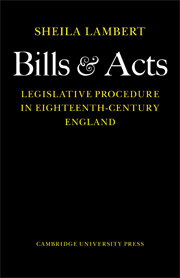Book contents
- Frontmatter
- Contents
- Preface
- Abbreviations
- Introduction
- 1 Robert Harper and parliamentary agency
- 2 Treatises and handbooks
- 3 The clerks: fees and agency
- 4 Parliamentary business
- 5 Private bill procedure
- 6 Estate bills
- 7 Inclosure bills
- 8 Local bills
- 9 Promulgation of the statutes
- 10 Conclusion
- Appendix I List of bills drawn by Robert Harper
- Appendix II Note on parliamentary sources
- Index
- Frontmatter
- Contents
- Preface
- Abbreviations
- Introduction
- 1 Robert Harper and parliamentary agency
- 2 Treatises and handbooks
- 3 The clerks: fees and agency
- 4 Parliamentary business
- 5 Private bill procedure
- 6 Estate bills
- 7 Inclosure bills
- 8 Local bills
- 9 Promulgation of the statutes
- 10 Conclusion
- Appendix I List of bills drawn by Robert Harper
- Appendix II Note on parliamentary sources
- Index
Summary
Being engaged in preparing a list of printed House of Commons sessional papers for the eighteenth century, I found myself relying upon a collection of such papers in the State Paper Room of the British Museum. Many of the printed bills bore manuscript annotations and notes of amendments, and at first I assumed they had belonged to a member of parliament and wondered whether it might be possible to identify him. I noticed that many papers also bore contemporary ink reference numbers and sometimes the initials ‘R.H.’ ; then I found one or two whose docket was endorsed ‘To Mr Harper’ and others marked ‘as drawn by R.H.’. Finding no member of that name, I set off in search of a lawyer named ‘R. Harper’. This book is the result of the search. It centres round the work of one attorney, hitherto completely unknown and without any official status. Its purpose is to illustrate the procedures by which legislation was prepared and enacted in the eighteenth century.
The legislative output of the century was so great that historians in political and economic fields who have little concern with legislation as such can scarcely escape touching upon the subject at some time. My purpose is to go behind the formal rules of procedure to show, by illustration, what actually took place in a number of cases and thus to suggest how any particular bill may have been initiated and put through to the statute book.
- Type
- Chapter
- Information
- Bills and ActsLegislative procedure in Eighteenth-Century England, pp. ix - xPublisher: Cambridge University PressPrint publication year: 1971



